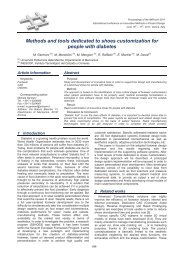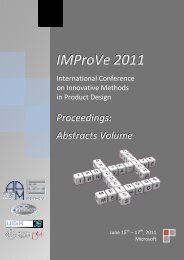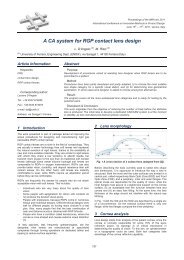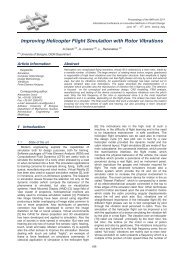IMProVe 2011 - Proceedings
IMProVe 2011 - Proceedings
IMProVe 2011 - Proceedings
Create successful ePaper yourself
Turn your PDF publications into a flip-book with our unique Google optimized e-Paper software.
Surveying, Mapping and GIS Techniques<br />
to the zones where took place the different stages (the assembly of the roman army, fight<br />
face to face, etc…). By the way have been done another study of the density of Iberic<br />
ceramic artifacts, that together with the presence of nails of the shelter tents, has provide<br />
an important indication to locate the zones where the roman and the Carthaginian army<br />
placed their camps.<br />
Discussion & Conclusion:<br />
In any case, it confirms that the application of the GIS in the battle scene of Baecula, bring<br />
us positives results.<br />
Keywords: Archaeology, G.I.S., Baecula, Battle<br />
Corresponding Author: Inmaculada Cardenas Anguita<br />
Tel.: + 34 953 213510<br />
e-mail: icardenasanguita@gmail.com<br />
Address: Paraje las lagunillas, Jaén (España)<br />
Methodology for the metric restoration<br />
of the historical cartography<br />
applied to Francisco Coello´s cartografic series<br />
of the Royal Site of Aranjuez<br />
J. C. Asenjo (a), C. San Antonio (a), R. García (a)<br />
(a) Universidad Politécnica de Madrid (UPM) Madrid/España<br />
Abstract:<br />
This study presents a process for restoring part of the 1860s cartographic series known as<br />
Hojas Kilométricas (Kilometric Sheets). Specifically, the study focuses on those sheets<br />
referring to the city centre and surrounding area of the Royal Site of Aranjuez, a town in<br />
the south of the Province of Madrid.<br />
The aim of this study is to restore the actual size and measurements of scanned images of<br />
the Hojas Kilométricas. This would allow us, among other things, to reestablish both the<br />
format and scale of the original plans. To achieve this goal it is necessary to rectify and<br />
then georeference these images, i.e. assign them a geographic reference system.<br />
This procedure is essential in the overlaying and comparison of the Hojas Kilométricas of<br />
the Royal Site with other historical cartography as well as other sources related to the<br />
same area from different time periods. Subsequent research would allow us, for example,<br />
to reconstruct the time-evolution of the urban area, to spot new construction and to<br />
pinpoint the locations of any altered or missing buildings or architectural features. In<br />
addition, this would allow us to develop and integrate databases for GIS models applicable<br />
to the management of our cultural heritage.<br />
June 15 th – 17 th , <strong>2011</strong>, Venice, Italy<br />
150<br />
<strong>IMProVe</strong> <strong>2011</strong> - <strong>Proceedings</strong>










